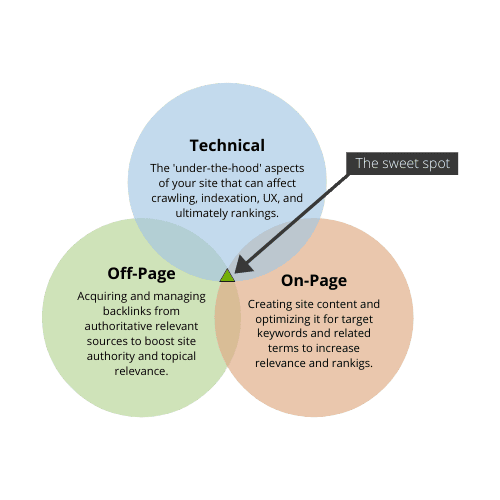If you have an eCommerce site, you might be surprised to hear that the most important thing is not about the product or how you present it. Instead, it’s about technical SEO.
Sometimes it is because people don’t know how to attract more organic traffic, and sometimes it is because they don’t know about certain aspects of technical SEO for eCommerce sites. This is where an SEO services company can come to your rescue.

If you have a business that sells products online, you will know just how important organic traffic can be. It can bring in a whole new audience for your business and help increase your revenue by a significant amount. However, most eCommerce sites are missing out on this type of traffic because they haven’t come across some essential tips regarding technical SEO.
7 Essential Tips to Drive Organic Traffic
- Drop the keyword-rich domain name
It is a common belief that a keyword-rich domain name will ensure a higher ranking in search engines for those keywords.
In the past, this was true because search engines were not as advanced as they are today. They relied heavily on the words contained in the title tag of the page to determine the topic of your site. In addition, they also relied on terms contained in the URL.
Today, search engines have moved away from relying so heavily on keyword-rich URLs and have become much better at interpreting keywords within the content to determine the topic.
The result is that a keyword-rich domain name is not as important as it used to be. It can hurt you if you try to stuff a ton of keywords into your domain name and end up with something that does not read well or looks unnatural.
To get more visitors from search engines, focus on producing high-quality content that contains your target keywords naturally and consistently throughout its body.
- Fix errors on your site
Most websites have some errors that can be found and fixed. Fixing these errors will improve your Google rankings and the number of visitors to your site.
If search engines do not index your website, the first thing you have to do is get it fixed. You can’t do any SEO if search engine bots are not indexing your site.
The most common reason for a site not being indexed is a technical problem on the website. For example, your robots.txt file may block search bots from crawling your site. If that’s the case, go to your site’s root directory and delete or edit the robots.txt file.
This will allow search bots to crawl your site and add it to their index. Once this is done, wait for a few days and re-check your website in the Google webmaster tool. This will give you an idea about when Googlebot last crawled/indexed your site, and you can make sure that everything looks fine in terms of content and structure to avoid unnecessary crawl delay (which might in turn cause de-indexation of the site).
- Add Google Webmasters Tools and Google Analytics to your website
You should add Google Webmasters Tools and Google Analytics to your website to better understand how Google sees your site. With this information, you can optimize your website for better ranking.
Webmasters tools
To add webmasters tools to your Google account, log in and start a new project. The project title should be the name of your website. Remember this because we will need it later when we connect the data from Google Webmaster Tools to Google Analytics. This project will be used to submit data about your website to Google.
There are two ways in which you can add the meta tags for your homepage:
1) You can upload an HTML file with the meta tags that you already have on your homepage. If you do not have any meta tags yet, we recommend using this method.
2) You can create a new HTML file and use the wizard function in Webmaster Tools to copy the proper meta tags to this file.
- Make sure your product pages are crawlable and indexable
How to make sure search engine bots can index your products? Simple, add a sitemap!
A sitemap is an XML file that lists all of the pages on your site. Search engines crawl these files and use their URLs to help determine which pages they should visit first. After all, if you want to find something on Amazon.com, do you look at every single page until you find what you’re looking for? Of course not. You use their convenient sitemap to find what you’re looking for immediately.
When it comes to optimizing your e-commerce site for SEO, this is just as true. Google gives preference to websites that use sitemaps because it makes it easier to crawl your site and index its content. This will help boost your rankings even if you don’t rank well for the keywords in your product title or product description (which we’ll discuss shortly).
- Use schema.org markup
The most common way to make your content more visible to Google is to use schema.org markup.
Schema.org is a collaborative effort by Google, Yahoo! and Microsoft to create standard vocabularies for marking up the structure of information on the Web. It’s supported by many of the major search engines, including Bing and Ask.com.
When you mark up your site with schema.org markup, it means that Google, Bing, Yahoo!, and other search engines will display some of your content more accurately in search results, which can improve your click-through rate (CTR).
What’s more, Google says it uses schema.org data as a ranking signal in some areas of search results — particularly in local search results, but potentially elsewhere as well.
Benefits of using schema.org include a more accurate representation of your site’s data in search engine results, improved CTR, more traffic from mobile devices, and a possible ranking boost in some areas.
- Ensure your products are correctly structured data
Structured data refers to cleanly presented and organized data so both computers and people can quickly parse it. By ensuring that your product pages are structured data, you will ensure that all of the content on those pages is indexed and will show up in Google’s search results.
The following tips will help you ensure that your product pages are correctly structured:
– Create a page for each unique product.
– Make sure it is listed with the product name as the <title> tag.
– Try to include as many product attributes as possible (i.e., size, color, material, etc.).
– Don’t include any unnecessary information like promotional text or images (you can add those separately).
– Create a page for unique attributes, such as size or color, if necessary.
-If you have a category of products with only one attribute, create a single page for that attribute and link to it from each of the products that come in that category.
- Optimize product images
One of the essential things that any site owner should do is upload high-quality product images that contain relevant and accurate information about their products or services. Using stock photos may seem like a good idea at first but does not work in the long run as they do not contain any valuable information and can easily be copied by your competitors.
The most crucial point to remember is that your product images must be optimized for search engines which will also improve your website’s speed . Optimized images can help you attain higher rankings and more targeted traffic from popular search engines such as Google, Bing and Yahoo!
Search engines use image recognition software to detect specific elements such as color, shape, size and even the text present in an image if your product image contains relevant information such as brand name, model number and price.
Conclusion

A technical SEO audit of your site will give you the data and the action steps you need to optimize your eCommerce site for organic traffic.



